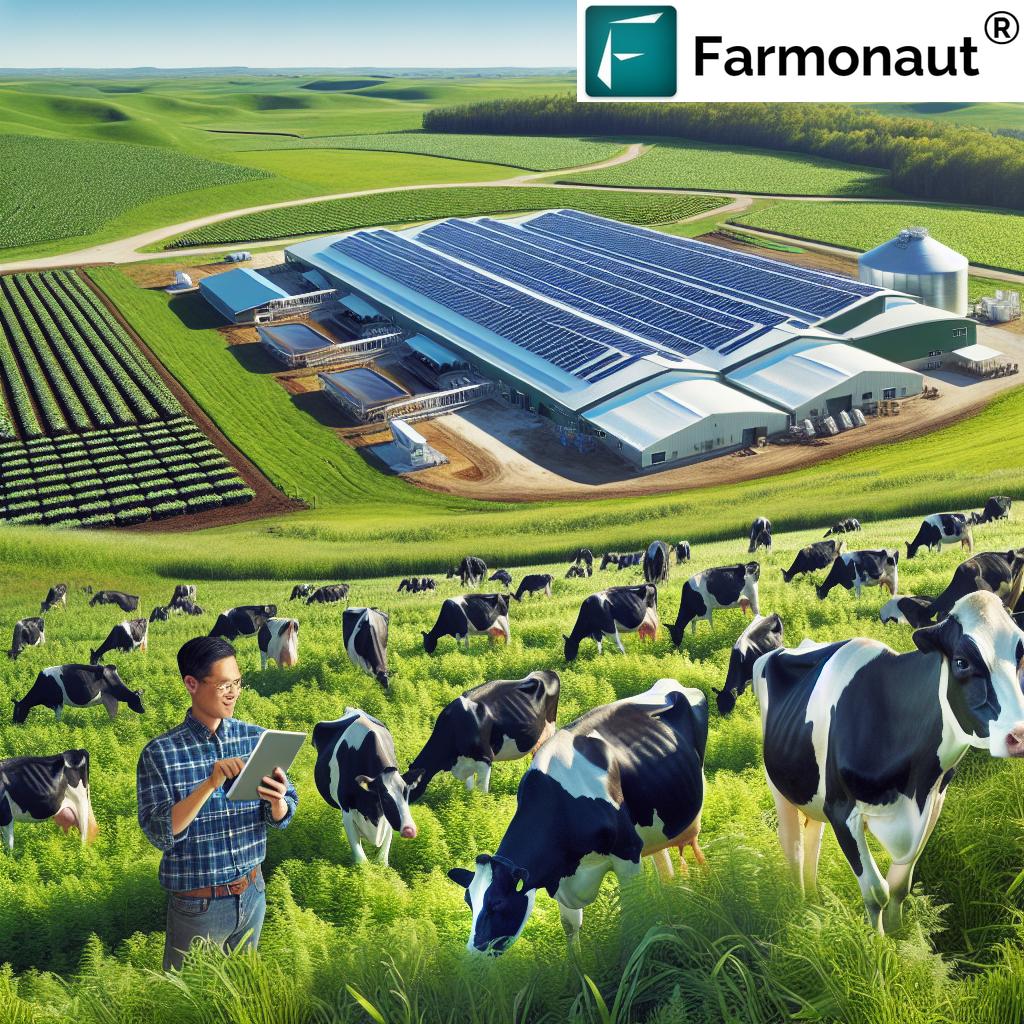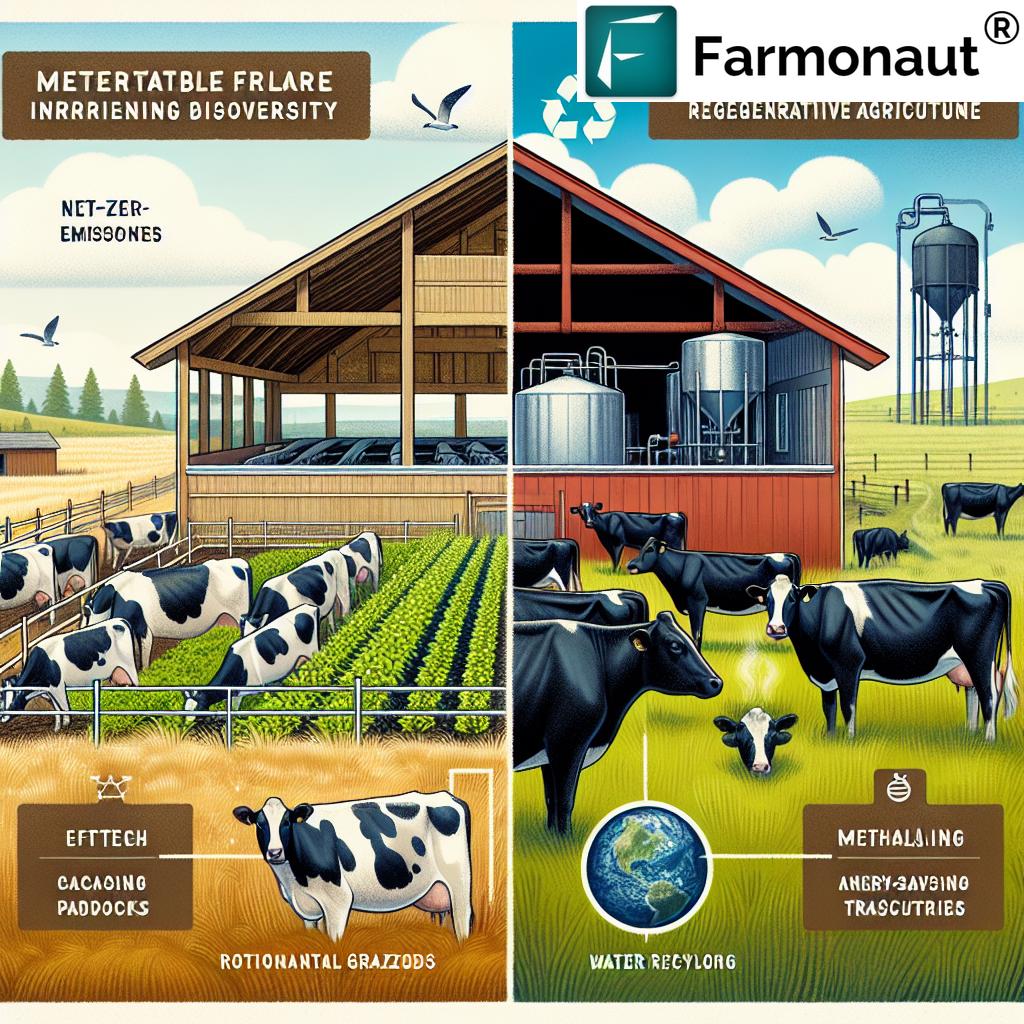Canadian Dairy Farms: Pioneering Sustainable Agriculture for a Net-Zero Future
“Canadian dairy farms are targeting net-zero emissions, with 94% of farms implementing sustainable agriculture practices.”
Welcome to our comprehensive exploration of Canadian dairy farms and their groundbreaking journey towards sustainable agriculture. As we delve into the world of innovative farming techniques and food safety in dairy production, we’ll discover how the industry is paving the way for a net-zero future. Join us as we uncover the remarkable efforts of Canadian dairy farmers in embracing regenerative agriculture practices, enhancing soil health, and supporting biodiversity across the nation.

The Canadian Dairy Industry: A Snapshot
The Canadian dairy industry stands as a cornerstone of the country’s agricultural sector, renowned for its commitment to quality, sustainability, and innovation. From the rolling hills of Quebec to the vast prairies of Alberta, dairy farms across Canada are embracing cutting-edge practices to ensure the production of nutritious milk while prioritizing environmental stewardship.
- Over 10,000 dairy farms across Canada
- Contributes significantly to the national economy
- Employs over 220,000 Canadians directly and indirectly
- Produces high-quality milk and dairy products
As we navigate through the intricacies of sustainable dairy farming, it’s crucial to recognize the role of advanced technologies in this transformation. Farmonaut, a pioneering agricultural technology company, offers satellite-based farm management solutions that are revolutionizing the way dairy farmers monitor and manage their land. Through its web application, Farmonaut provides valuable insights into crop health and land optimization, supporting the sustainable practices we’ll explore in this article.
Embracing Sustainable Agriculture Practices
Canadian dairy farmers are at the forefront of implementing sustainable agriculture practices, with a strong focus on reducing their environmental footprint while maintaining high standards of milk production. Let’s explore some of the key initiatives driving this green revolution in the dairy sector:
- Regenerative Agriculture: Enhancing soil health and carbon sequestration
- Water Conservation: Implementing efficient irrigation systems and water recycling
- Emissions Reduction: Adopting technologies to minimize greenhouse gas emissions
- Biodiversity Support: Creating habitats for wildlife and promoting ecosystem balance
These practices not only contribute to environmental preservation but also ensure the long-term viability of dairy farming in Canada. By leveraging tools like Farmonaut’s satellite and weather API, farmers can make data-driven decisions to optimize their land use and resource management.
Innovative Farming Techniques in Canadian Dairy
Innovation is at the heart of Canadian dairy farming’s sustainable transformation. From precision agriculture to advanced animal welfare practices, farmers are embracing a wide array of innovative techniques:
- Precision Feeding: Utilizing AI-driven systems to optimize cow nutrition
- Robotic Milking: Improving efficiency and animal comfort
- Smart Barns: Implementing IoT devices for climate control and animal monitoring
- Methane Capture: Installing biodigesters to convert waste into renewable energy
These innovative approaches are supported by technologies like Farmonaut’s mobile applications, available for both Android and iOS devices, which help farmers track and optimize their operations on the go.
The Nutritional Benefits of Canadian Milk
While focusing on sustainability, Canadian dairy farmers continue to produce milk of exceptional nutritional value. Let’s examine the key benefits of Canadian milk:
- Rich source of calcium and vitamin D
- High-quality protein for muscle health
- Essential vitamins and minerals for overall well-being
- Naturally low in sodium
The commitment to producing nutritious milk goes hand in hand with sustainable practices, ensuring that Canadians have access to healthy dairy products while supporting environmental conservation.
Food Safety in Dairy Production
Maintaining the highest standards of food safety is paramount in Canadian dairy production. The industry adheres to rigorous certification processes and quality control measures to ensure that every drop of milk meets strict safety criteria:
- Canadian Quality Milk Program: A comprehensive on-farm food safety program
- Regular Testing: Milk is tested for quality and safety at multiple stages
- Traceability Systems: Implementing advanced tracking from farm to table
- Stringent Regulations: Adherence to federal and provincial food safety laws
These robust safety measures ensure that Canadian milk and dairy products maintain their reputation for quality and purity.
“Over 80% of Canadian dairy farms use regenerative agriculture techniques to enhance soil health and support biodiversity.”
Regenerative Agriculture: Nurturing Soil and Biodiversity
Regenerative agriculture practices are becoming increasingly prevalent on Canadian dairy farms, playing a crucial role in enhancing soil health and supporting biodiversity. These practices include:
- Cover cropping to prevent soil erosion and increase organic matter
- Rotational grazing to improve pasture health and carbon sequestration
- Minimizing tillage to preserve soil structure and microbial life
- Integrating trees and shrubs to create wildlife corridors and habitats
By adopting these methods, dairy farmers are not only improving their land’s productivity but also contributing to the overall health of the ecosystem. Farmonaut’s satellite-based crop health monitoring tools assist farmers in tracking the impact of these practices on their land, enabling data-driven decision-making for optimal results.

Water Conservation and Management
Water is a precious resource, and Canadian dairy farms are implementing innovative strategies to conserve and manage it effectively:
- Precision irrigation systems to reduce water waste
- Rainwater harvesting for non-potable farm uses
- Wastewater treatment and recycling
- Drought-resistant forage crops to minimize water needs
These water conservation efforts not only reduce the environmental impact of dairy farming but also contribute to the industry’s resilience in the face of climate change. Farmonaut’s tools, accessible through their API Developer Docs, provide farmers with valuable insights into soil moisture levels and weather patterns, enabling more efficient water management.
Carbon Reduction Strategies in Dairy Farming
Reducing carbon emissions is a key priority for Canadian dairy farms as they work towards net-zero goals. Some of the innovative strategies being employed include:
- Implementing energy-efficient technologies in milking and cooling systems
- Utilizing renewable energy sources such as solar and wind power
- Optimizing feed formulations to reduce enteric methane emissions
- Adopting precision agriculture techniques to minimize input use and emissions
These efforts are supported by advanced monitoring tools, including Farmonaut’s carbon footprinting feature, which helps agribusinesses track and reduce their environmental impact in real-time.
Research Driving Improvements in Cow Health
Ongoing research in cow health is central to the sustainable development of Canadian dairy farming. Key areas of focus include:
- Genetic selection for improved health and longevity
- Advanced nutrition strategies to enhance cow well-being and productivity
- Development of vaccines and treatments for common dairy cattle diseases
- Implementation of stress-reduction techniques in farm management
By prioritizing cow health, Canadian dairy farms are not only improving animal welfare but also increasing the efficiency and sustainability of milk production.
| Farming Aspect | Traditional Methods | Innovative Sustainable Practices |
|---|---|---|
| Soil Management | Intensive tillage, chemical fertilizers | No-till farming, cover crops, organic amendments (60% adoption) |
| Water Conservation | Flood irrigation, unmonitored usage | Precision irrigation, rainwater harvesting (40% adoption) |
| Emissions Reduction | No specific measures | Methane digesters, energy-efficient equipment (30% adoption) |
| Animal Welfare | Basic housing and care | Robotic milking, comfort-focused barns (50% adoption) |
| Feed Production | Monoculture crops, high pesticide use | Diverse crop rotations, integrated pest management (70% adoption) |
| Waste Management | Open lagoons, land application | Anaerobic digestion, composting (35% adoption) |
| Energy Use | Fossil fuel dependency | Solar panels, wind turbines, energy-efficient systems (25% adoption) |
The Role of Technology in Sustainable Dairy Farming
Technology plays a pivotal role in advancing sustainable practices on Canadian dairy farms. From satellite imaging to AI-driven analytics, farmers are leveraging cutting-edge tools to optimize their operations:
- Satellite-based crop monitoring for precise land management
- AI-powered systems for early disease detection in cattle
- Blockchain technology for enhanced traceability and transparency
- IoT sensors for real-time monitoring of farm conditions
Farmonaut’s suite of tools, including their web application, exemplifies how technology can empower farmers to make data-driven decisions that benefit both their operations and the environment.
Adapting to Environmental Challenges
Canadian dairy farmers are proactively adapting to environmental challenges, implementing strategies to ensure the resilience of their operations:
- Developing drought-resistant forage varieties
- Implementing flood mitigation measures on low-lying farms
- Adjusting farming schedules to accommodate changing climate patterns
- Investing in infrastructure to protect against extreme weather events
These adaptive measures, supported by data from tools like Farmonaut’s weather forecasting features, help ensure the long-term sustainability of Canadian dairy production in the face of climate change.
The Future of Canadian Dairy Farming
As we look to the future, Canadian dairy farming is poised to continue its trajectory towards greater sustainability and innovation. Key trends shaping the industry’s future include:
- Increased adoption of circular economy principles in farm operations
- Further integration of AI and machine learning in farm management
- Development of carbon-neutral or carbon-negative dairy farms
- Expansion of regenerative agriculture practices across the sector
With ongoing research, technological advancements, and a commitment to environmental stewardship, Canadian dairy farms are well-positioned to lead the way in sustainable agriculture for years to come.
Conclusion: A Sustainable Vision for Canadian Dairy
As we’ve explored throughout this article, Canadian dairy farms are at the forefront of pioneering sustainable agriculture practices. From innovative farming techniques to rigorous food safety measures, the industry is committed to producing high-quality, nutritious milk while minimizing its environmental impact. The journey towards net-zero emissions is well underway, with farmers across the country embracing regenerative agriculture, water conservation, and carbon reduction strategies.
The future of Canadian dairy farming looks bright, with technology playing a crucial role in driving further improvements. Tools like Farmonaut’s satellite-based farm management solutions are empowering farmers to make data-driven decisions that benefit both their operations and the environment. As the industry continues to adapt to environmental challenges and push the boundaries of innovation, Canadian dairy farms are setting a global standard for sustainable agriculture.
By supporting Canadian dairy, consumers are not just choosing nutritious products; they’re also contributing to a more sustainable food system and a healthier planet. As we move forward, the Canadian dairy industry remains committed to its vision of a net-zero future, continuing to balance productivity with environmental stewardship and animal welfare.
FAQs
- Q: What is net-zero emissions agriculture?
A: Net-zero emissions agriculture refers to farming practices that aim to balance the greenhouse gases emitted with an equivalent amount removed from the atmosphere, resulting in no net increase in emissions. - Q: How are Canadian dairy farms reducing their carbon footprint?
A: Canadian dairy farms are reducing their carbon footprint through various methods, including implementing energy-efficient technologies, using renewable energy sources, optimizing feed formulations to reduce methane emissions, and adopting precision agriculture techniques. - Q: What are some examples of regenerative agriculture practices used on Canadian dairy farms?
A: Examples include cover cropping, rotational grazing, minimizing tillage, and integrating trees and shrubs to create wildlife habitats. - Q: How does technology contribute to sustainable dairy farming in Canada?
A: Technology contributes through satellite-based crop monitoring, AI-powered systems for disease detection, blockchain for traceability, and IoT sensors for real-time monitoring of farm conditions. - Q: What measures are in place to ensure food safety in Canadian dairy production?
A: Food safety measures include the Canadian Quality Milk Program, regular testing at multiple stages, advanced traceability systems, and adherence to stringent federal and provincial food safety regulations.




